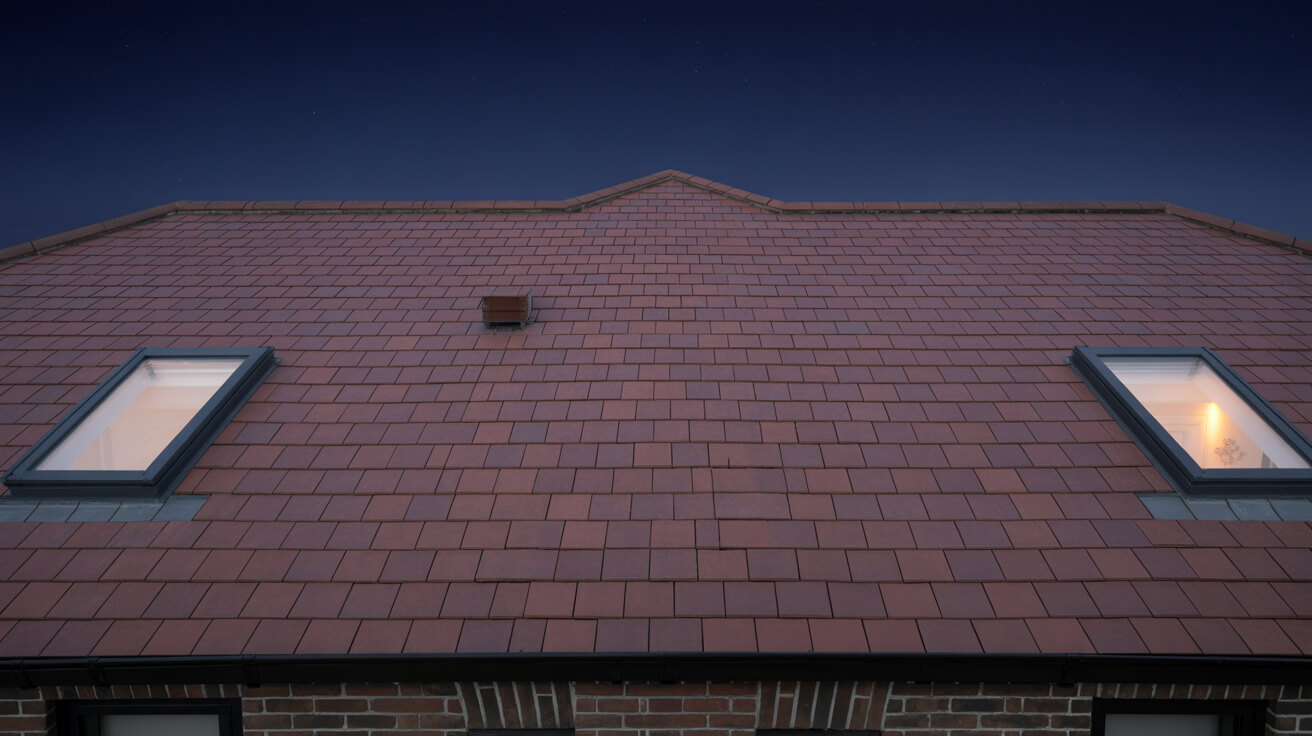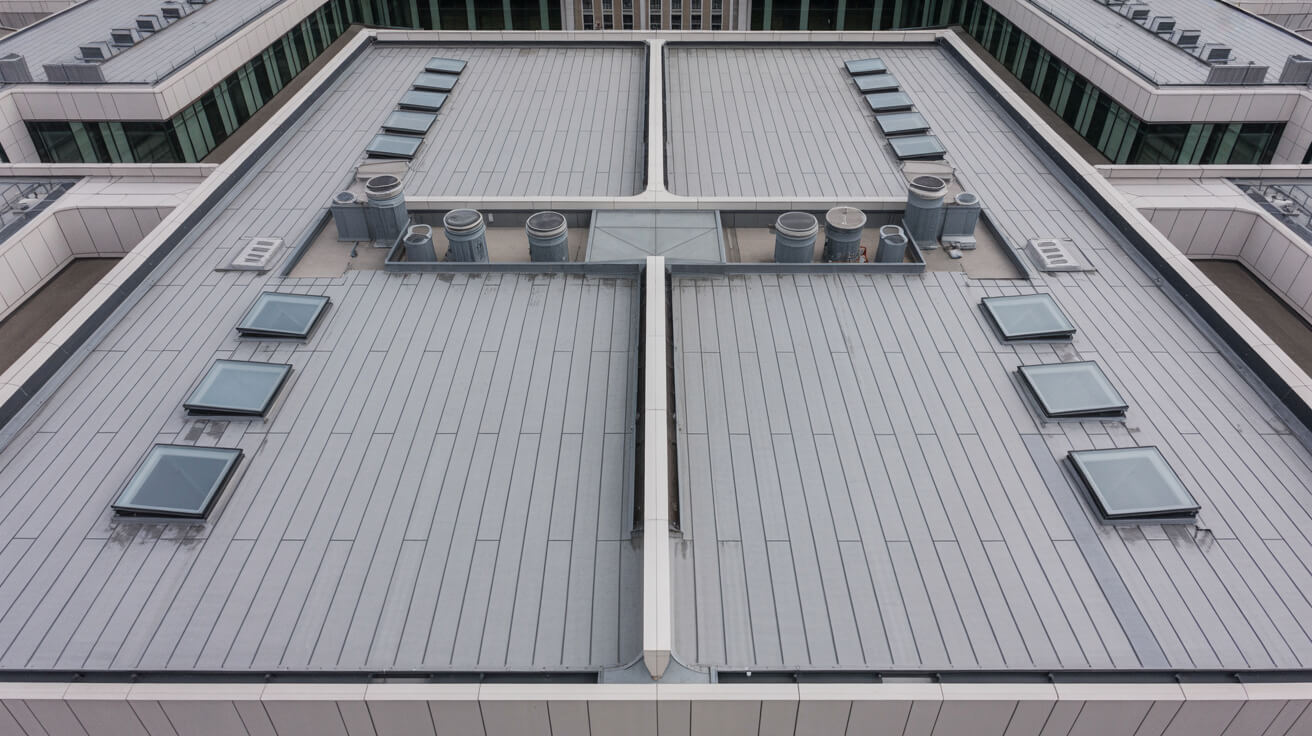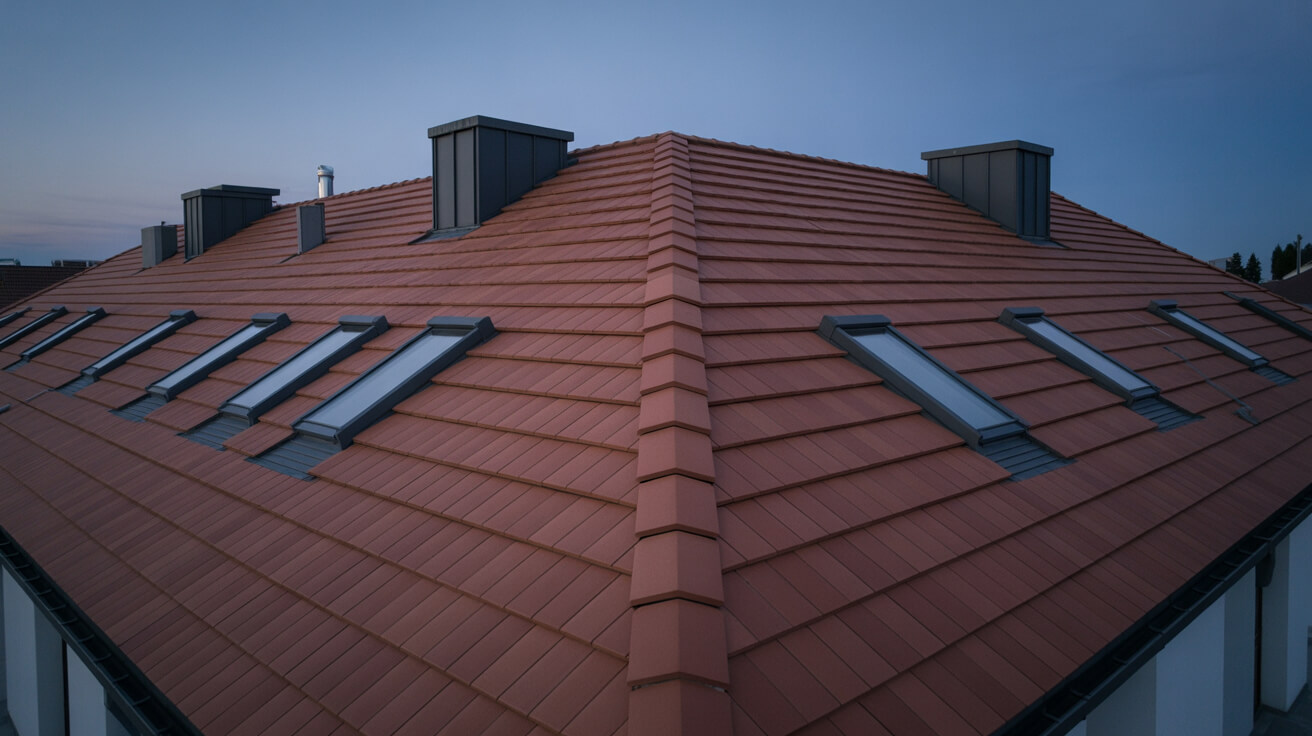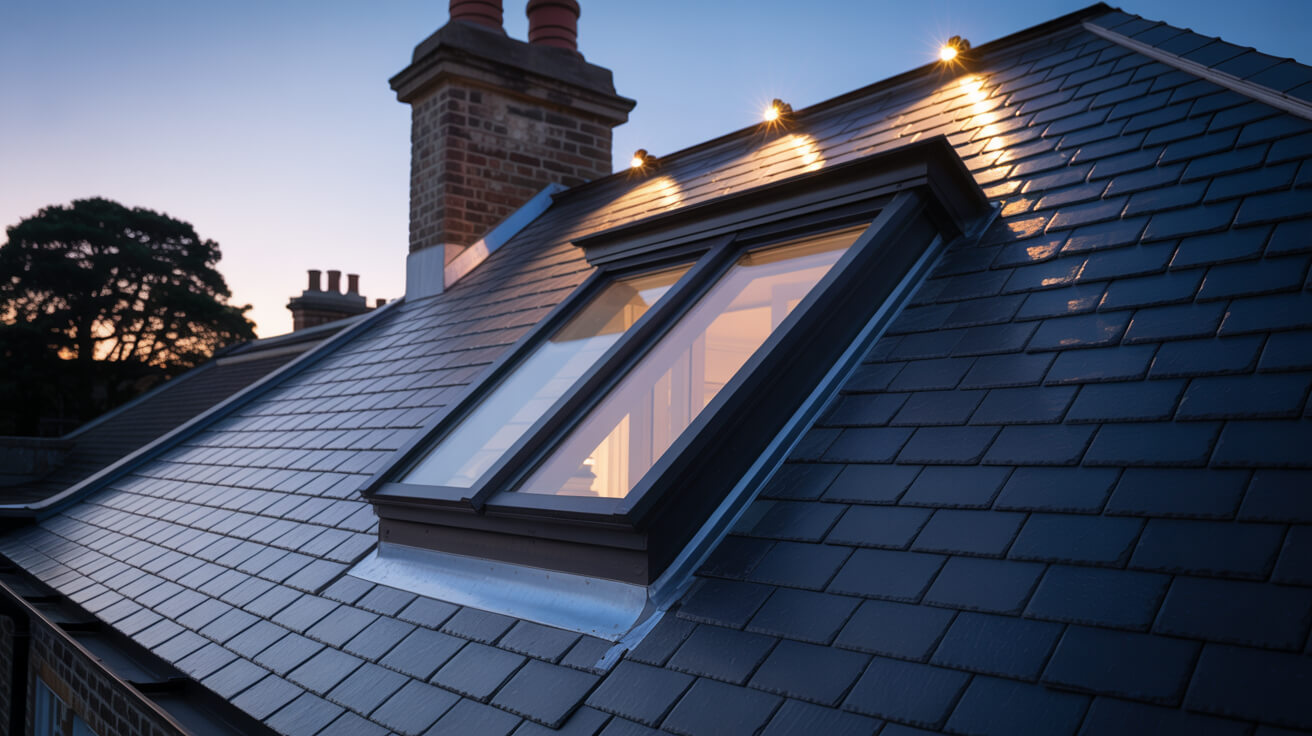TPO Roofing Re-Roofing protects your property against leaks, damp, and energy loss—delivering compliant, durable results for homes, businesses, and heritage sites across London and the Home Counties. Every re-roof is completed with care, reliability, and proven performance from a team that understands your property’s risks.
Backed by years of experience, Which Trusted Trader and CITB credentials, and materials from Welsh Slate, ALM Lead, and Kemper, our team delivers consistently high standards. Book a free survey today and protect your property.

Ignoring roofing issues risks leaks, damp, insulation failure, and rising structural damage—turning small problems into expensive emergencies. Delaying only raises future costs and puts your property’s value, comfort, and efficiency at stake.

Professional TPO Roofing Re-Roofing puts you back in control, with better weather protection, energy performance, and compliance for homes, commercial buildings, or heritage properties. It’s a smart investment whether you need urgent repairs, an upgrade, or long-term protection—delivering peace of mind, efficiency, and lasting value across property types.
TPO Roofing Re-Roofing covers installations, repairs, upgrades, and restorations for homes, business sites, and heritage properties across London and the Home Counties. Each project prioritises Building Regulations compliance and long-term resilience, using only high-quality, trusted supplier materials—always tailored for safety and value.








Every TPO Roofing Re-Roofing project is adapted to property type, roof structure, and environmental demands. Tailoring ensures compliance with regulations, minimises disruption, and maximises long-term value. From homes and businesses to industrial sites and listed heritage buildings, our flexible approach guarantees roofing solutions that meet unique needs while delivering safety, efficiency, and reliability.
Homes, extensions, and listed buildings.
Offices, retail, schools, and hospitality.
Warehouses, factories, and logistics sites.
Every TPO Roofing Re-Roofing project follows proven steps with quality materials. Whether a new installation, upgrade, or repair, each layer adds durability, safety, and efficiency—tailored to protect your property and meet regulatory standards.

Get a free, no-obligation quote today.
Our experts are standing by to help you choose the perfect flat roofing solution.
⏱ Response within 24 hours guaranteed
Accredited by Which Trusted Trader, CITB, and approved by Kemper and Westwood, our team delivers safe, compliant, and warranty-protected TPO Roofing Re-Roofing projects. These credentials mean guaranteed standards and long-term assurance—reinforced by the positive client reviews that consistently highlight quality, professionalism, and trust.


Complete reroofing. Living in Singapore at the time and T was super responsive and communicative.
Replacement of lead box gutter and new flashing to parapet wall. I had an excellent experience using James and the team. He was very prompt in all aspects of communication and completed a first class job. Really pleased.
James completed some repairs on our roof and replaced some of our pebble dash by the roof as well. He was very thorough and fixed everything. He kept us really informed by taking photos and showing us what he did and keeping us updated. It also went onto our neighbours roof and he did the same fo...
We had a leak in our bedroom and James fixed the roof for us to stop it from leaking. All the work came with a warranty. The work that was carried out was good. James and his team were polite, and did all the work quickly and without too much interruption to our day-to-day lives. Would recommend ...
J G Leadworks have repaired and replaced the roofs and gulleys over our warehouse and workshops which have meant both areas are now watertight
James and team were incredibly responsive to my request to look at a serious leak issue on my flat roof. They did a very thorough investigation and explained in detail the issue and gave a fair quote. They were quick to book in and complete the work and have checked in afterwards a few times to m...
James was quick to respond to the initial contact and was able to work around some time constraints I had. He explained what needed doing clearly and was happy to answer follow up questions. He took pictures to show each stage and I feel confident in the work that was done by James and the team. ...
JG Roofing were very easy to work with. Their quote was sensible and they stuck to that figure. They completed many repairs to my roof including, rebuilding a leaded gutter, reinforcing rotten rafters, rebuilding a long felted gutter and felting parapet walls, resurfacing and felting a flat roof,...
Planning and legal checks protect clients from costly errors, delays, and non-compliance, ensuring roofing projects meet regulatory and safety requirements.
Permission is typically required for listed properties, conservation areas, or major roof alterations. All projects must also satisfy Building Regulations, including Part A (structural safety) and Part L (energy efficiency), ensuring compliant and future-proofed installations.
Our team manages the full process, from initial surveys to legal guidance, preparing documentation, and liaising with local authorities where needed. Whether working on modern homes or heritage sites, we ensure every project is delivered legally, safely, and with minimal disruption—providing complete reassurance and peace of mind to property owners.

Every project unites skilled workmanship with rigorously tested materials.

With 25 years of experience in lead sheet roofing, James is a trusted expert in heritage roofing, slate, and tiling. His knowledge of traditional methods, paired with modern compliance, makes him a go-to specialist for projects that demand both craftsmanship and durability.
TPO Roofing Re-Roofing provides lasting protection, efficiency, and value, delivering durable, compliant roofing solutions that safeguard every type of property investment.
Selecting TPO Roofing Re-Roofing involves balancing durability, budget, compliance, and aesthetics to secure the best-fit roofing solution for your property.
Why Clients Choose JG Leadwork and Roofing
With decades of trade experience, our teams understand the unique demands of London and Home Counties roofing. From heritage-listed properties to contemporary extensions, we adapt solutions to local regulations, weather conditions, and architectural styles with precision.
Accredited by Which Trusted Trader, CITB, and approved by Kemper, Westwood, IKO, ALM, and other leading suppliers.
These credentials guarantee safety, compliance, and access to manufacturer-backed warranties, giving clients peace of mind that their project meets the highest professional standards and benefits from warranty protection.
Our heritage projects use Welsh Slate and handmade clay tiles for authenticity, while leadwork is delivered to Lead Sheet Association (LSA) standards. Commercial installations employ Kemper and Westwood liquid systems for durability and efficiency. Each example demonstrates our reliability, blending traditional craftsmanship with modern performance.
Our workforce includes skilled roofers, heritage specialists, and safety-certified installers.
Every roofer holds NVQs, receives ongoing CPD training, and is qualified in both modern flat systems and traditional techniques, including slate and leadwork.
Team structure ensures projects run smoothly—surveyors identify needs, installers deliver with precision, and supervisors oversee compliance. This approach minimises disruption, accelerates timelines, and guarantees consistent quality across residential, commercial, and industrial roofing projects.
Every project is regulation-compliant, warranty-backed, and focused on long-term results.
Client testimonials and case studies confirm our track record, with projects praised for professionalism, durability, and customer support.
We go beyond installation with aftercare packages, maintenance support, and open communication at every stage. Property owners gain reassurance that JG Leadwork and Roofing stands behind its work. Book a free survey today and discover why homeowners, landlords, and businesses trust us with their roofing.

Get a free quote, rapid response, and expert service across London and the Home Counties. Contacting JG Leadwork and Roofing is your simple first step to dependable roofing solutions.
We source materials from leading suppliers including Supreme and IKO felt systems, Kemper, Westwood and Proteus liquid systems, Welsh Slate, handmade clay tiles, ALM Lead Mills, and Nicholson Air Track. These trusted brands guarantee durability, compliance, and warranty-backed performance across flat, pitched, heritage, and commercial roofing projects.
.
.
For homes, TPO Roofing Re-Roofing safeguards comfort and enhances kerb appeal with durable, energy-efficient systems. Whether modern extensions or traditional pitched roofs, tailored solutions improve living standards and protect property value.
For businesses, TPO Roofing Re-Roofing delivers cost-effective, large-scale installations with minimal disruption. Projects are planned around operations, with safety compliance, energy performance, and flexible scheduling built in—supporting offices, retail, schools, and industrial facilities with reliable, regulation-ready outcomes.
For heritage properties, TPO Roofing Re-Roofing combines authentic materials such as Welsh slate, handmade clay tiles, and ALM lead with skilled conservation techniques. Listed building consent and conservation requirements are fully managed, ensuring traditional character is preserved while integrating modern weatherproofing. This careful balance provides long-term durability without compromising historic integrity or aesthetic value.
JG Leadwork and Roofing delivers TPO Roofing Re-Roofing across housing, commercial, heritage, and public sectors. Every industry comes with unique requirements, from safety and compliance to efficiency and conservation. Our adaptability ensures projects are delivered with precision and professionalism—whether safeguarding homes, supporting business continuity, preserving history, or protecting critical public and healthcare facilities.
Durable roofing installed with minimal disruption, ensuring safe, regulation-compliant workspaces for staff and visitors.
High-standard, compliance-focused solutions protect community facilities while meeting strict safety and regulatory obligations.
Heavy-duty roofing tailored for wide spans, ventilation, and long-term maintenance efficiency.
Authentic materials and sensitive methods preserve historic character while adding modern protection.
Weatherproof systems that enhance kerb appeal and guarantee uninterrupted trading for outlets.
Tailored roofing improves guest comfort, safety, and ambience across hotels, restaurants, and venues.
Safe, durable systems designed for schools and universities with minimal learning disruption.
Specialist roofing solutions built for hygiene, safety, and regulatory compliance in medical environments.
Our team of NVQ-qualified roofers, LSTA-trained specialists, and health & safety-compliant professionals bring decades of combined experience. Every project is delivered with meticulous attention to detail, ensuring safe practices and consistent quality across flat, pitched, heritage, and commercial roofing disciplines.
Expertise includes heritage leadwork, slate and tile roofing, modern flat systems, and drone-assisted roof surveys. Ongoing CPD training ensures adaptability to both traditional craftsmanship and the latest innovations—giving clients confidence that every roof is built or repaired with proven skill and care.

A thorough survey highlights existing issues, structural considerations, and upgrade opportunities, ensuring the best-fit solution is identified from the very beginning.
Transparent, itemised quotes detail costs, timelines, and materials—giving you complete clarity and confidence before work starts, with no hidden surprises.
Scaffolding, access solutions, and robust safety measures are put in place to safeguard both property and people throughout the project.
Skilled roofers complete the work using accredited materials and proven techniques, delivering durable, compliant results while keeping disruption to a minimum—whether for repairs, replacements, or new installations.
Each stage is inspected against manufacturer standards and Building Regulations, with photographic documentation provided for transparency and peace of mind.
Each stage is inspected against manufacturer standards and Building Regulations, with photographic documentation provided for transparency and peace of mind.
In a competitive roofing market, many providers look the same on paper. JG Leadwork and Roofing stands out through proven expertise, accredited methods, and specialist techniques. Our combination of traditional craftsmanship and modern technology makes us the safer, smarter choice across residential, commercial, industrial, and heritage projects.
In a competitive roofing market, many providers look the same on paper. JG Leadwork and Roofing stands out through proven expertise, accredited methods, and specialist techniques. Our combination of traditional craftsmanship and modern technology makes us the safer, smarter choice across residential, commercial, industrial, and heritage projects.


At JG Leadwork and Roofing, every project follows a structured QA process. Each stage—materials, installation, safety, and final sign-off—is measured against manufacturer specifications and UK Building Regulations to ensure durability, compliance, and warranty-backed performance across all roofing services.
Projects are only signed off once all QA checks are complete, giving clients confidence in long-term performance, structural safety, and insurance-backed peace of mind.
Every TPO Roofing Re-Roofing project by JG Leadwork and Roofing is delivered in strict alignment with UK Building Regulations and recognised frameworks. This ensures structural safety, energy efficiency, durability, and protects warranties and insurance coverage across residential, commercial, industrial, and heritage properties.
Clients can be confident their project is completed legally, safely, and insurance-ready—delivering long-term performance, compliance assurance, and complete peace of mind.
Property owners often wonder about TPO Roofing Re-Roofing—from costs and timescales to permissions. Below, you’ll find straightforward, trustworthy answers to the most frequent and practical queries.
Flat roof failures are a leading concern for property owners and project managers, especially because early failure can mean significant property damage, expensive repairs, and potential insurance headaches. In the UK’s climate—with its cycles of heavy rain, freeze–thaw, and wind uplift—understanding why flat roofs sometimes underperform helps you prevent avoidable problems. Here, we break down the typical root causes, practical clues, and inspection cues for premature flat roof failure.
The roofing membrane acts as the primary waterproof barrier. Over time, even modern membranes degrade due to UV exposure, thermal expansion, and routine wear. In traditional systems (such as felt), hairline cracks or “crazing” can allow water to breach micro-gaps, while older single-ply or poorly installed TPO may develop seam splits or blisters.
Symptoms:
Risks:
Water ingress from membrane failure often leads to interstitial damp (moisture trapped between insulation and the deck), causing timber rot or corrosion in metal decks. In the UK, older built-up felt typically lasts 10–15 years. TPO and other modern membranes, when properly installed and maintained, often exceed 20 years (UK Roofing Manufacturers Association, 2024). Early deterioration, however, can accelerate more extensive failures.
Flashing—the reinforcement around roof edges, upstands, penetrations, and junctions—can become a weak point if poorly installed, aged, or incompatible with the membrane. Inadequate detailing at skylights, balustrades, or parapet walls may invite rainwater driven by wind (“wind uplift”) to penetrate the structure. A common issue is capillary action, where water is drawn through hairline gaps between flashing and membrane due to surface tension.
How to spot it:
Risks:
Unnoticed leaks may compromise insurance claims if maintenance is neglected or if water ingress damages structural elements. According to BS5534, all flashings should be mechanically fixed and well sealed to resist wind uplift at exposed UK sites.
Flat roofs are especially susceptible to ponding water—standing pools remaining for 24+ hours after rainfall—if the slope (known as “fall”) is insufficient. BS6229 recommends a fall of at least 1:40 (finished fall 1:80) to counteract settlement and weathering. Persistent ponding accelerates membrane wear, encourages moss or root intrusion, and leads to freeze–thaw damage in winter.
Design and environmental triggers:
UK energy efficiency regulations (Part L) require proper insulation and assessment of condensation risk, yet shortcuts or poor workmanship still contribute to early failures.
Early identification is crucial. In addition to visual checks, professionals use:
A quick reference table:
| Root Cause | Typical Symptom | Risk if Ignored | Indicative Remedy |
|---|---|---|---|
| Aged/brittle membrane | Blistering, soft spots, leaks | Damp, rot, decay | Reroof or local repairs |
| Faulty/lifted flashing | Damp at upstands, visible gaps | Structural ingress | Re-detail, re-fix |
| Ponding water/blocked fall | Pools, green stains, ice in winter | Premature failure | Improve falls/drainage |
| Poor insulation/ventilation | Mould, cold spots, musty smell | Condensation, damp | Insulation, vapour layer |
A professional inspection—using a blend of visual, physical, and advanced diagnostic techniques—pinpoints the real causes of premature flat roof failure. Addressing these risks protects your property and can substantially extend the service life of your roof.
A roof replacement in London typically ranges from £90 to £200 or more per square metre, shaped by material choice, regulatory requirements, site complexities, and London’s unique property stock. Property owners and managers are often surprised at this variance, but clarity on the drivers behind these costs allows for realistic budgeting and proactive planning. Breaking down the main factors enables informed decision-making rooted in both compliance and value for money.
Labour and materials make up the majority of the total cost. In London, labour averages 40–55% of the project due to higher wages and the demand for accredited specialists. Material costs make up 45–60%, and the spectrum is wide depending on what you select.
Common roofing material costs:
Labour increases for complex access, height restrictions, or listed properties. Material selection fundamentally shapes cost, durability, and maintenance profile across decades.
UK roofing regulations strongly influence both design and budget. Part L of the Building Regulations sets benchmarks for energy efficiency—every new or replacement roof must meet minimum thermal standards, usually demanding high-quality insulation that achieves a U-value (how much heat can pass through a material) of 0.18 W/m²K or lower for flat roofs. Not meeting this exposes owners to failed inspections and higher heating costs.
For pitched roofs, BS 5534 prescribes technical requirements like roof batten sizes, underlay types, and fixing patterns—especially to combat wind uplift risks. Fulfilling this may require additional timberwork or stronger fixings, impacting material and labour costs.
Legal compliance also means notifying Building Control, triggering inspection fees—expect £200–£400 for approvals.
London’s urban density and property heritage add further layers. Many homes require complex scaffolding, which can run £1,000–£4,000 depending on site and street access. Victorian terraces and listed buildings often restrict the use of modern materials; conservation rules may compel the use of natural slate or traditional detailing, leading to higher supplier costs and longer delivery times.
Environmental factors—like river proximity or exposure to prevailing winds—increase the need for robust membranes, reinforced flashing, or specialist installation methods. Periods of high demand, post-Brexit supply chain issues, or material inflation further complicate price certainty.
Here’s a quick reference for comparing typical London roof replacement costs:
| **Factor** | **Per m² / Total** | **Notes** |
|---|---|---|
| TPO Membrane (fitted) | £100–£140 | Long-life, energy-efficient |
| Slate (nat./synth.) | £90–£180 | Needed for heritage/conservation |
| Tile (concrete/clay) | £70–£120 | Most common on residential homes |
| Insulation (reg. min.) | £25–£45 | Required for **Part L** compliance |
| Scaffolding | £1,000–£4,000 (total) | Varies by access and building type |
| Building Control | £200–£400 (total) | For legal and regulatory sign-off |
Key assessment steps:
Understanding these specific, regulated variables arms you to judge quotes, schedule works efficiently, and ensure your finished roof is legal, robust, and future-ready—all while avoiding unwelcome surprises from hidden London costs.
The time needed to instal a new roof in the UK varies with the roofing type, property size, season, and site accessibility. Most flat roofs on standard homes are installed in 2–4 days. Pitched roof replacements typically take 4–8 working days for a typical terraced or semi-detached house, while extensive, complex, or heritage re-roofing can run to two weeks or even longer. Timelines matter because they shape cost, disruption, and how well building contents and occupants stay protected from weather. Landlords, facilities teams, and heritage building stewards rely on accurate planning to keep works efficient, safe, and minimally disruptive.
A roof’s timeline is shaped not just by size, but by the hidden details beneath.
Flat Roofs:
Pitched Roofs:
Projects on large commercial blocks or listed heritage sites (e.g. those with ornate leadwork or intricate carpentry) can extend to 2 weeks or several months when complex access, council permissions, or traditional skills are required.
Several site and environmental factors shift the expected timeline:
A sudden freeze or unplanned wet rot discovery can add crucial days to a project.
Routine care extends a roof’s life and keeps minor damage from spiralling:
Waiting for a visible leak nearly always costs more in the long run.
| Material | Typical Lifespan | Inspection Frequency | Maintenance Needs |
|---|---|---|---|
| **Slate** | 80–100+ years | Every 5 years | Minimal: replace broken slates |
| **Concrete Tile** | 50–70 years | Every 3 years | Replace cracked tiles, re-bed ridges |
| **Felt** | 10–20 years | Every 2 years | Reseal joins, patch blisters |
| **Single-ply membrane** | 20–30 years | Every 1–2 years | Clean outlets, repair punctures |
| **Liquid-applied system** | 25–40 years | Every 3 years | Watch for cracks, recoat as needed |
Key Terms:
Staying proactive with maintenance and regular checks helps every type of roof last to its full, designed lifespan—while neglect often cuts that life short and speeds up the need for another full re-roof.
When considering TPO re-roofing, most property owners want to know two things: what it will realistically cost, and how they’re protected against unexpected future expenses. Transparent pricing and robust warranties deliver crucial financial predictability—whether you’re a homeowner managing budgets, a landlord responsible for long-term upkeep, or a business leader aiming to reduce operational risk. Understanding what drives cost, how warranties safeguard your roof, and why booking with a properly accredited installer matters is essential for making a low-risk, cost-effective decision.
Several distinct cost factors shape the total price of TPO re-roofing. The primary variables are roof size, complexity, labour, specification (such as insulation or high-performance membranes), and access logistics—for instance, restricted urban locations versus easy-access bungalows. While figures vary by region and project, the following table summarises typical ranges:
| Service Type | Typical Range (UK) | Key Influences |
|---|---|---|
| Roof Repair | £250 – £1,200 | Damage type, access, materials |
| Roof Replacement | £5,000 – £15,000+ | Size, structure, insulation, finish |
On a per-square-metre basis, TPO systems are often more economical over the roof’s lifespan because they demand less maintenance and demonstrate superior energy efficiency. Additional costs will arise for large, multi-faceted roofs or if scaffolding or decking replacements are required. Always ask for a line-by-line quote so you know exactly what’s included—especially with features like vapour barriers, insulation upgrades, and edge trims that influence cost and compliance.
A robust insurance-backed warranty is standard on quality TPO re-roofing projects. These warranties typically range from 10 to 20 years and cover major faults in both the TPO membrane and installation labour. Manufacturers’ material guarantees are usually tied to proper application—so a work defect, membrane failure, or premature leak is fixed without question.
Key warranty elements:
A strong warranty also simplifies compliance. Under UK Building Regulations (notably Part L), improved insulation and airtightness are mandatory when replacing a roof. A compliant, warrantied installation is much more likely to satisfy building control and future property insurers.
The single biggest risk factor in re-roofing is a poorly qualified contractor. Using an accredited installer reduces the threat of mistakes, ensures legal compliance, and is often required to activate a manufacturer’s warranty. Look for:
A trusted installer will maintain paperwork (e.g., insurance, guarantees, certifications) and proactively document each project stage. This provides proof of compliance for insurers and future buyers—helping to preserve your asset’s value.
Cutting corners on a TPO re-roofing project is rarely a bargain. Common shortcuts—like overlaying membranes on rotten decking, skipping insulation upgrades, or omitting vapour barriers—can cause major problems:
These risks can easily outweigh any perceived initial savings. In the end, investing in proven systems and accredited workmanship protects your property’s value and shields you from expensive surprises.